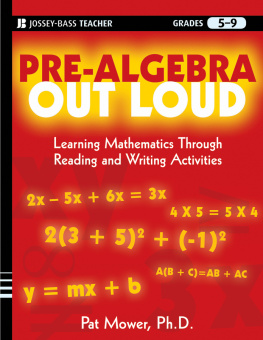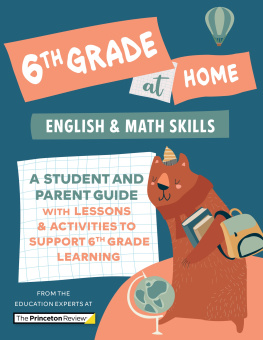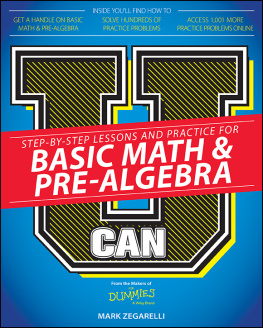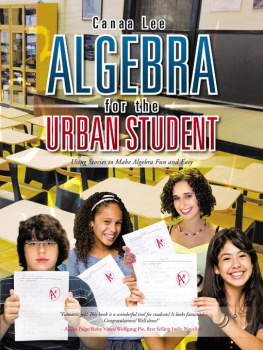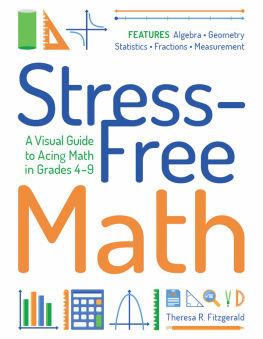
Jossey-Bass Teacher
Jossey-Bass Teacher provides educators with practical knowledge and tools to create a positive and lifelong impact on student learning. We offer classroom-tested and research-based teaching resources for a variety of grade levels and subject areas. Whether you are an aspiring, new, or veteran teacher, we want to help you make every teaching day your best.
From ready-to-use classroom activities to the latest teaching framework, our value-packed books provide insightful, practical, and comprehensive materials on the topics that matter most to K12 teachers. We hope to become your trusted source for the best ideas from the most experienced and respected experts in the field.
Other titles in Out Loud series.
Algebra Out Loud
Geometry Out Loud
Copyright 2013 by John Wiley & Sons, Inc. All rights reserved.
Published by Jossey-Bass
A Wiley Imprint
One Montgomery Street, Suite 1200, San Francisco, CA 94104-4594 www.josseybass.com
No part of this publication may be reproduced, stored in a retrieval system, or transmitted in any form or by any means, electronic, mechanical, photocopying, recording, scanning, or otherwise, except as permitted under Section 107 or 108 of the 1976 United States Copyright Act, without either the prior written permission of the publisher, or authorization through payment of the appropriate per-copy fee to the Copyright Clearance Center, Inc., 222 Rosewood Drive, Danvers, MA 01923, 978-750-8400, fax 978-646-8600, or on the Web at www.copyright.com. Requests to the publisher for permission should be addressed to the Permissions Department, John Wiley & Sons, Inc., 111 River Street, Hoboken, NJ 07030, 201-748-6011, fax 201-748-6008, or online at www.wiley.com/go/permissions.
Limit of Liability/Disclaimer of Warranty: While the publisher and author have used their best efforts in preparing this book, they make no representations or warranties with respect to the accuracy or completeness of the contents of this book and specifically disclaim any implied warranties of merchantability or fitness for a particular purpose. No warranty may be created or extended by sales representatives or written sales materials. The advice and strategies contained herein may not be suitable for your situation. You should consult with a professional where appropriate. Neither the publisher nor author shall be liable for any loss of profit or any other commercial damages, including but not limited to special, incidental, consequential, or other damages. Readers should be aware that Internet Web sites offered as citations and/or sources for further information may have changed or disappeared between the time this was written and when it is read.
Jossey-Bass books and products are available through most bookstores. To contact Jossey-Bass directly call our Customer Care Department within the U.S. at 800-956-7739, outside the U.S. at 317-572-3986, or fax 317-572-4002.
Wiley also publishes its books in a variety of electronic formats and by print-on-demand. Not all content that is available in standard print versions of this book may appear or be packaged in all book formats. If you have purchased a version of this book that did not include media that is referenced by or accompanies a standard print version, you may request this media by visiting http://booksupport.wiley.com. For more information about Wiley products, visit us at www.wiley.com.
ISBN: 9780470539491
About the Author
Pat Mower is an associate professor in the Department of Mathematics and Statistics at Washburn University in Topeka, Kansas. She earned her B.S. in mathematics and English at Dickinson University in Dickinson, North Dakota, and both her M.S. in mathematics and statistics and her Ph.D. in teacher education with emphasis in mathematics at the University of North Dakota. She is the author of three books on reading and writing to learn mathematics strategies and activities, all published by Jossey-Bass. Pat currently teaches Math for Middle School Educators, History of Math, Exploring Mathematics, and an online version of Exploring Mathematics. Her interests are in the history of mathematics and using ancient methods for solving problems and also in the pedagogy of freshman mathematics.
Acknowledgments
I am grateful for the patience and support of my husband, Derek; my mother who recently passed; my older brother, John C.; and my basset hounds, who were just happy to have me home at the computer. I am especially grateful to my editors and guides, Nana Twumasi and Kate Bradford, who believed in the vision of this book and pushed me to finish it.
Introduction
Pre-Algebra Out Loud, like the other books in the Out Loud series, is based on the premise that students will perform better in mathematics if they learn to read mathematical content more efficiently, pinpoint and study the important content with better retention, and write well in several different formats about mathematical concepts.
Too often, students learn about mathematics only from watching the teacher do problems and repeating these examples. These activities are considered tried-and-true learning strategies, but if we want students to think deeply or to challenge themselves to truly get it, we must ask them to read, interpret (think), and write about the content in their own words.
Meant for use as a supplemental resource, Pre-Algebra Out Loud provides several successful classroom-tested reading and writing strategies and activities that can be used to help students learn math at a deep level. Some of these activities ask students to paraphrase math text, create word maps, and build and use graphic organizers and tables. Other reading and writing to learn pre-algebra activities include the creation of written problems, a math glossary, and biographies of mathematicians. The activities are meant to teach students how to read, think, and write mathematics efficiently, effectively, and accurately.
The following eight chapters focus on the main pre-algebra topics: the basic tools of algebra; exploring infinite sets; topics in integers; number theory; fractions, decimals, and percents; equations and inequalities; visualizing algebra by graphing; and geometry. Each chapter contains two mini-lessons, as well as activities and reproducible worksheets that you can copy and use in your classroom. All reading and writing activities and strategies have been classroom tested with successful results.
The topics and activities are aligned with the new Common Core State Standards (CCSS) Initiative, a concrete description of standard practice for teaching K--12 mathematics. This is a state-led effort coordinated by the National Governors Association Center for Best Practices (NGA Center) and the Council of Chief State School Officers (CCSSO). The standards were developed in collaboration with teachers, school administrators, and experts, to provide a clear and consistent framework to prepare our children for college and the workforce (Common Core Initiative, 2011). This practical and necessary initiative:
Make[s] sense of problems and persevere[s] in solving them.
Reason[s] abstractly and quantitatively.
Construct[s] viable arguments and critique[s] the reasoning of others.
Model[s] with mathematics.
Use[s] appropriate tools strategically.
Attend[s] to precision (know when and how to give exact answers).
Look[s] for and make[s] use of structure.
Look[s] for and express[es] regularity in repeated reasoning [Common Core Initiative, 2011].
These eight standards form the basic practice of mathematics. give the appropriate standards from the CCSS for the curriculum in grades 6 through 8 that is addressed in each chapter of this book. Since
Next page
